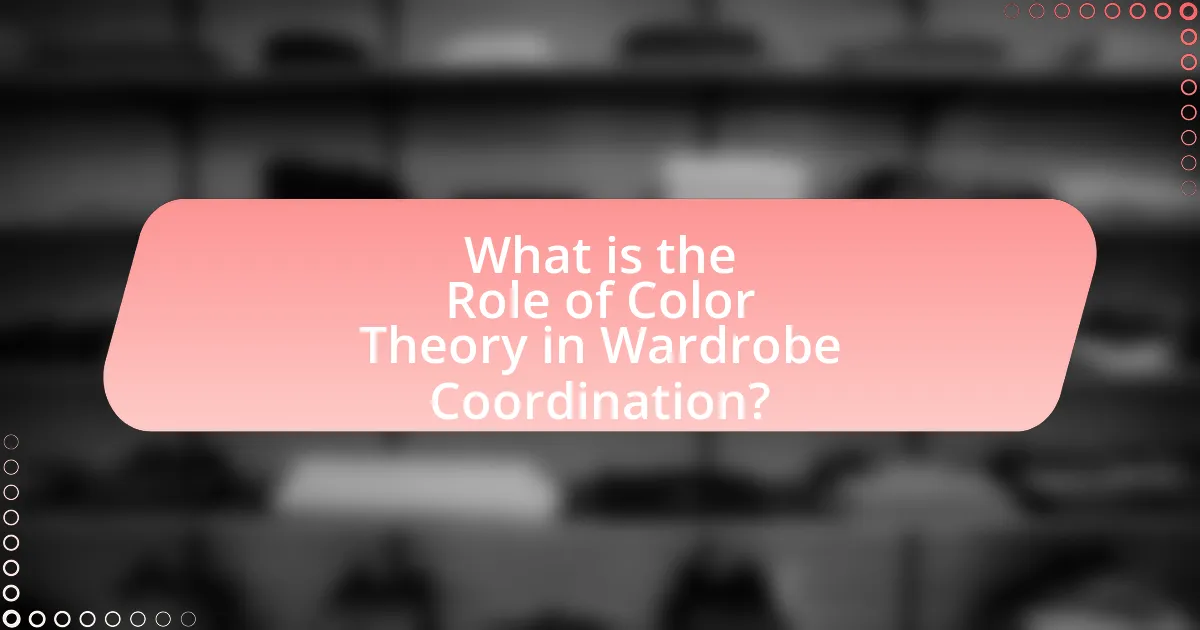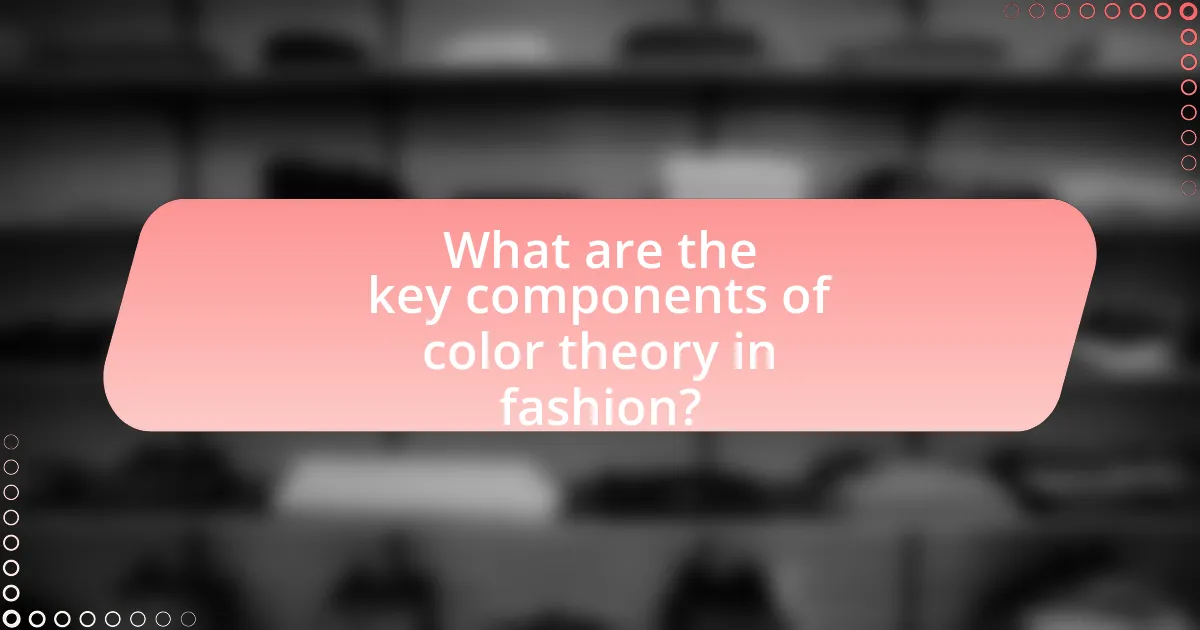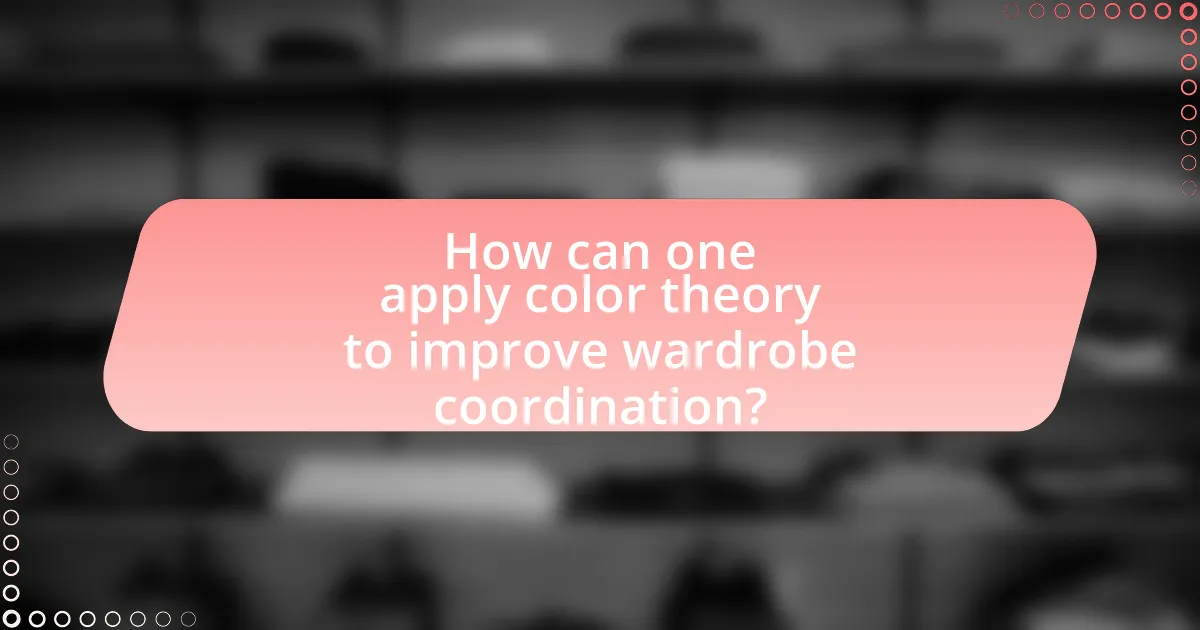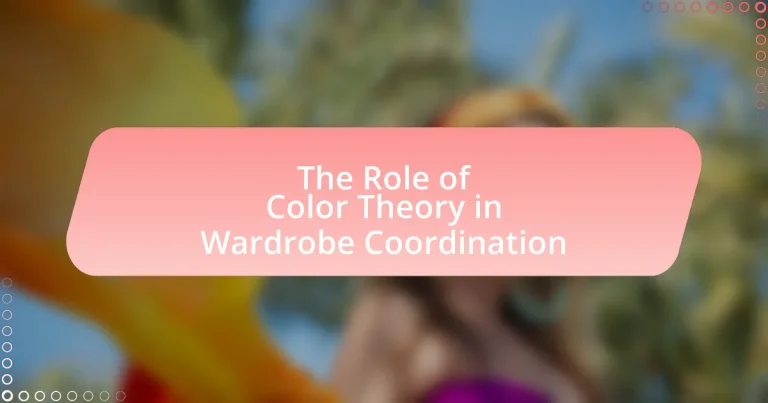The article focuses on the role of color theory in wardrobe coordination, emphasizing its significance in selecting colors that enhance personal style and appearance. It outlines the basic principles of color theory, including the color wheel, color harmony, and the psychological effects of colors, which guide individuals in creating visually appealing outfits. The discussion includes how color choices influence perceptions of professionalism and attractiveness, the emotional responses evoked by different colors, and practical strategies for applying color theory to improve wardrobe coordination. Additionally, it addresses common mistakes to avoid and resources for further learning about color theory in fashion.

What is the Role of Color Theory in Wardrobe Coordination?
Color theory plays a crucial role in wardrobe coordination by guiding individuals in selecting colors that complement each other, enhancing overall appearance and style. This theory categorizes colors into primary, secondary, and tertiary groups, and explains relationships such as complementary, analogous, and triadic schemes, which help in creating visually appealing outfits. For instance, complementary colors, which are opposite each other on the color wheel, can create striking contrasts that draw attention, while analogous colors, which are next to each other, provide a harmonious look. Studies in fashion psychology indicate that color choices can influence perceptions of professionalism and attractiveness, underscoring the importance of color theory in making informed wardrobe decisions.
How does color theory influence personal style choices?
Color theory significantly influences personal style choices by guiding individuals in selecting colors that enhance their appearance and express their personality. The principles of color harmony, contrast, and the psychological effects of colors help individuals create cohesive outfits that reflect their desired image. For instance, studies show that colors like blue evoke feelings of calmness and trust, while red can convey energy and passion. This understanding allows individuals to strategically choose colors that align with their mood or the impression they wish to make, ultimately shaping their personal style.
What are the basic principles of color theory relevant to fashion?
The basic principles of color theory relevant to fashion include the color wheel, color harmony, and the psychological effects of colors. The color wheel organizes colors into primary, secondary, and tertiary categories, providing a visual guide for creating color combinations. Color harmony refers to aesthetically pleasing arrangements of colors, such as complementary, analogous, and triadic schemes, which help in achieving balance and visual interest in outfits. Additionally, colors evoke psychological responses; for example, blue often conveys calmness, while red can signify passion. Understanding these principles allows fashion designers and consumers to make informed choices that enhance personal style and emotional impact.
How do color harmonies affect outfit selection?
Color harmonies significantly influence outfit selection by guiding individuals in combining colors that create visually appealing and cohesive looks. When selecting an outfit, understanding color harmonies—such as complementary, analogous, and triadic schemes—helps individuals choose colors that enhance their appearance and express their personal style. For example, complementary colors, which are opposite each other on the color wheel, create high contrast and vibrant outfits, while analogous colors, which are next to each other, produce a more harmonious and subtle effect. Research in color theory indicates that these harmonies can affect perceptions of attractiveness and mood, reinforcing the importance of color choices in fashion.
Why is understanding color psychology important in wardrobe coordination?
Understanding color psychology is important in wardrobe coordination because it influences perceptions, emotions, and social interactions. Different colors evoke specific feelings; for example, blue is often associated with calmness and trust, while red can signify passion and energy. This psychological impact can affect how individuals are perceived in social and professional settings, ultimately influencing their confidence and interactions. Research indicates that color can affect mood and behavior, as shown in studies like “Impact of Color on Marketing” by Satyendra Singh, which highlights how color can increase brand recognition by up to 80%. Therefore, effectively utilizing color psychology in wardrobe choices can enhance personal branding and communication.
What emotions do different colors evoke in fashion?
Different colors evoke specific emotions in fashion, influencing perceptions and feelings. For instance, red often symbolizes passion and energy, making it a popular choice for attention-grabbing outfits. Blue typically conveys calmness and trust, frequently used in professional attire to promote a sense of reliability. Yellow is associated with happiness and optimism, often incorporated into casual wear to uplift moods. Green represents nature and tranquility, commonly found in eco-friendly fashion choices. Black signifies sophistication and power, making it a staple in formal wear. White embodies purity and simplicity, often used in minimalist designs. These associations are supported by color psychology research, which indicates that colors can significantly affect human emotions and behaviors.
How can color choices impact social perceptions?
Color choices significantly impact social perceptions by influencing emotions, behaviors, and judgments about individuals. For instance, research indicates that colors like red can evoke feelings of excitement and passion, while blue tends to promote calmness and trustworthiness. A study published in the journal “Color Research and Application” by researchers Andrew Elliot and Markus Maier found that individuals wearing red were perceived as more attractive and dominant, while those in blue were seen as more reliable and peaceful. This demonstrates that color not only affects personal expression but also shapes how others interpret social cues and characteristics.

What are the key components of color theory in fashion?
The key components of color theory in fashion include the color wheel, color harmony, and the psychological effects of colors. The color wheel serves as a visual representation of colors and their relationships, categorizing them into primary, secondary, and tertiary colors. Color harmony refers to the aesthetically pleasing combinations of colors, such as complementary, analogous, and triadic schemes, which guide designers in creating visually appealing outfits. Additionally, the psychological effects of colors influence consumer behavior and emotional responses, with studies showing that colors can evoke specific feelings and perceptions, impacting fashion choices and trends.
What are the primary colors and their significance in wardrobe choices?
The primary colors are red, blue, and yellow, and they significantly influence wardrobe choices by serving as foundational hues that can be combined to create a wide range of colors. Red often symbolizes passion and energy, making it a popular choice for statement pieces; blue conveys calmness and professionalism, frequently chosen for work attire; and yellow represents optimism and cheerfulness, often used in accessories or casual wear. These colors are essential in color theory, as they can be mixed to produce secondary colors, allowing for versatile and harmonious outfit combinations.
How do primary colors interact with secondary and tertiary colors?
Primary colors interact with secondary and tertiary colors through mixing and contrast. When primary colors—red, blue, and yellow—are combined, they create secondary colors: red and blue make purple, blue and yellow make green, and red and yellow make orange. Tertiary colors arise from mixing a primary color with a secondary color, resulting in hues like red-orange or blue-green. This interaction is fundamental in color theory, as it establishes a color wheel that guides wardrobe coordination by helping individuals understand complementary and analogous color schemes, enhancing visual appeal and harmony in clothing choices.
What role do neutral colors play in outfit coordination?
Neutral colors serve as foundational elements in outfit coordination, providing versatility and balance. They allow for easy mixing and matching with other colors, enhancing the overall aesthetic without overwhelming the outfit. For instance, shades like beige, gray, and white can complement bolder colors, creating a harmonious look. Studies in color theory indicate that neutral tones can evoke feelings of calmness and sophistication, making them essential for creating polished ensembles.
How can the color wheel be utilized for effective wardrobe coordination?
The color wheel can be utilized for effective wardrobe coordination by helping individuals identify complementary, analogous, and triadic color schemes. Complementary colors, which are opposite each other on the wheel, create high contrast and vibrant looks, while analogous colors, located next to each other, provide a harmonious and cohesive appearance. Triadic color schemes, formed by selecting three colors evenly spaced around the wheel, offer a balanced yet dynamic outfit. Utilizing these principles allows for intentional color combinations that enhance personal style and visual appeal, supported by color theory which emphasizes the psychological effects of color in fashion.
What are complementary colors and how can they enhance outfits?
Complementary colors are pairs of colors that, when combined, cancel each other out, producing a grayscale color like white or black; they are located opposite each other on the color wheel, such as blue and orange or red and green. These colors enhance outfits by creating high contrast and visual interest, making the overall look more vibrant and dynamic. For example, wearing a blue dress with orange accessories can draw attention and create a striking appearance, which is supported by color theory principles that suggest complementary colors can evoke emotional responses and enhance aesthetic appeal.
How do analogous colors create cohesive looks?
Analogous colors create cohesive looks by utilizing colors that are adjacent to each other on the color wheel, which naturally harmonize and complement one another. This color scheme fosters a sense of unity and balance in an outfit, as the colors share similar undertones and create a smooth transition between shades. For example, a combination of blue, blue-green, and green can evoke a serene and cohesive appearance, making it visually appealing. Studies in color theory indicate that analogous color schemes are often used in design and fashion to evoke specific emotions and enhance aesthetic appeal, reinforcing the effectiveness of this approach in wardrobe coordination.

How can one apply color theory to improve wardrobe coordination?
One can apply color theory to improve wardrobe coordination by utilizing the color wheel to create harmonious outfits. The color wheel categorizes colors into primary, secondary, and tertiary groups, allowing individuals to identify complementary, analogous, and triadic color schemes. For instance, pairing complementary colors, such as blue and orange, creates a vibrant contrast, while analogous colors, like blue, green, and teal, offer a more subtle and cohesive look. Research indicates that color combinations can influence perceptions of style and attractiveness, as seen in studies showing that well-coordinated colors enhance overall visual appeal. By understanding and applying these principles, individuals can enhance their wardrobe coordination effectively.
What strategies can be used to create a balanced color palette in outfits?
To create a balanced color palette in outfits, one effective strategy is to use the 60-30-10 rule, which suggests that 60% of the outfit should be a dominant color, 30% a secondary color, and 10% an accent color. This approach ensures visual harmony and prevents overwhelming the viewer with too many colors. Additionally, utilizing a color wheel can help in selecting complementary or analogous colors, which naturally work well together. For instance, pairing blue with orange (complementary) or green with blue (analogous) can enhance the overall aesthetic. Research in color theory indicates that color combinations can significantly affect perceptions and emotions, reinforcing the importance of a balanced palette in fashion choices.
How can seasonal color analysis aid in wardrobe planning?
Seasonal color analysis aids in wardrobe planning by identifying the colors that complement an individual’s natural features, such as skin tone, hair color, and eye color. This analysis categorizes individuals into seasonal palettes—spring, summer, autumn, or winter—each associated with specific color characteristics. For instance, a person classified as a “summer” typically looks best in soft, muted colors, while an “autumn” individual may shine in warm, earthy tones. By utilizing this framework, individuals can make informed choices when selecting clothing, ensuring that their wardrobe consists of colors that enhance their appearance and create cohesive outfits. Studies in color theory support the effectiveness of this approach, demonstrating that wearing colors aligned with one’s seasonal palette can boost confidence and improve overall aesthetic appeal.
What are some common mistakes to avoid when coordinating colors?
Common mistakes to avoid when coordinating colors include using too many contrasting colors, neglecting the color wheel, and failing to consider skin tone. Using too many contrasting colors can create visual chaos, making outfits appear disjointed. Neglecting the color wheel leads to poor color combinations that clash rather than complement. Additionally, failing to consider skin tone can result in colors that wash out the wearer or create an unflattering appearance. Understanding these principles is essential for effective color coordination in wardrobe choices.
What practical tips can enhance wardrobe coordination using color theory?
To enhance wardrobe coordination using color theory, individuals should utilize the color wheel to create harmonious outfits. By understanding complementary colors, which are opposite each other on the wheel, one can pair items like blue and orange for a striking contrast. Additionally, using analogous colors, which are next to each other, such as blue, blue-green, and green, can create a cohesive look. Research indicates that color combinations can influence perceptions of style and professionalism; for instance, a study published in the Journal of Experimental Psychology found that colors can affect mood and behavior, reinforcing the importance of color choices in wardrobe coordination.
How can one effectively mix patterns and colors in outfits?
To effectively mix patterns and colors in outfits, one should start by choosing a dominant color that anchors the look, ensuring that all patterns and colors complement this base. For instance, using a neutral color as a foundation allows for the introduction of bolder patterns and colors without overwhelming the outfit. Additionally, incorporating patterns of varying scales—such as pairing a large floral print with a smaller geometric design—creates visual interest while maintaining harmony. Color theory supports this approach, as analogous colors (those next to each other on the color wheel) tend to blend well, while complementary colors (those opposite each other) can create striking contrasts when used thoughtfully. This method is validated by fashion experts who emphasize the importance of balance and cohesion in outfit coordination.
What resources are available for learning more about color theory in fashion?
Books, online courses, and academic journals are valuable resources for learning about color theory in fashion. Notable books include “Color: A Course in Mastering the Art of Mixing Colors” by Betty Edwards, which provides foundational knowledge on color mixing and theory. Online platforms like Coursera and Skillshare offer courses specifically focused on color theory in fashion design, often taught by industry professionals. Additionally, academic journals such as the “International Journal of Fashion Design, Technology and Education” publish research articles that explore the application of color theory in fashion, providing evidence-based insights and case studies.


